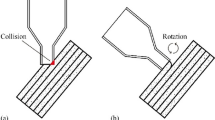Abstract
Industrial robotics currently focuses on the utilization within clearly defined production environments. A paradigm shift away from repetition of static tasks towards dynamic human–robot collaboration is noticeable, specifically due to developments triggered by Industry 4.0 concepts. Within construction industries static automation can only be achieved at a prefabrication level; through these new developments adaptable robotics can be utilized for new concepts of on-site robotic assistance. Within this paper, we illustrate our approach towards robotics that adapts to changing environmental conditions and material features. Simultaneously we take advantage of existing pre-planning methods within computer-aided design (CAD). In order to take full advantage of the mixed human and machine work environments within construction, we enable on-site adaptation towards a pre-planned assembly strategy. We show our applications within the assembly of complex timber structures as well as transfer of the concept towards other construction tasks. By combining a priori knowledge from the design phase with haptic interaction primitives, we enable intuitive human–robot collaboration. For this approach the term of haptic programming was coined, which allows the exchange of knowledge between the user and a robot on a physical level.









Similar content being viewed by others
References
Aggarwal Luv (2014) Reconfigurable validation model for identifying kinematic singularities and reach conditions for articulated robots and machine tools. Electronic Theses and Dissertations. 5219. https://scholar.uwindsor.ca/etd/5219l Accessed 05 Aug 2018
Arntz M et. al (2018) Digitalisierung und die Zukunft der Arbeit: Makroökonomische Auswirkungen auf Beschäftigung Arbeitslosigkeit und Löhne von morgen
Borghesan G, Willaert B, De Schutter J (2012) A constraint-based programming approach to physical human-robot interaction. In: IEEE international conference on robotics and automation, Saint Paul, MN, pp 3890–3896
Braumann J, Brell-Cokcan S (2011) Parametric robot control: integrated CAD/CAM for architectural design. In: Proceedings of the 31st annual conference of the association for computer aided design in architecture (ACADIA), Banff
Brell-Cokcan S, Braumann J (2014) Robotic production immanent design: creative toolpath design in micro and macro scale. In: Proceedings of the 34th annual conference of the association for computer aided design in architecture (ACADIA), Los Angeles
De Schutter J et al (2007) Constraint-based task specification and estimation for sensor-based robot systems in the presence of geometric uncertainty. Int J Robot Res 26:433–455
Eastman C et al (2011) BIM Handbook: A Guide to Building Information Modeling for Owners, Managers, Designers, Engineers and Contractors, 2nd edn. Wiley, Hoboken
Hayes B, Scassellati B (2014) Discovering task constraints through observation and active learning. In: IEEE/RSJ international conference on intelligent robots and systems, Chicago, IL, pp 4442–4449
Huang Y, Zhang X, Chen X, Ota J (2017) Vision-guided peg-in-hole assembly by Baxter robot. Adv Mech Eng 9(12):1–9. https://doi.org/10.1177/1687814017748078
Jaillon L, Poon CS (2014) Life cycle design and prefabrication in buildings: a review and case studies in Hong Kong. Autom Constr 39:195–202
Kerber E, Heimig T, Stumm S, Oster L, Brell-Cokcan S, Reisgen U (2018) Towards robotic fabrication in joining of steel. In: International symposium of automation and robotics in construction (ISARC)
Lutscher E et al (2018) Hierarchical force and positioning task specification for indirect force controlled robots. IEEE Trans Robot 34(1):280286
Ruffaldi E, Di Fava A, Loconsole C (2017) Vibrotactile feedback for aiding robot kinesthetic teaching of manipulation tasks. In: 26th IEEE international symposium on robot and human interactive communication (RO-MAN), 2017. IEEE
Saidi KS, Bock T, Georgoulas C (2016) Robotics in construction. In: Siciliano B, Khatib O (eds) Springer handbook of robotics. Springer, New York, p 14931520
Sandy T, Giftthaler M, Dörfler K, Kohler M, Buchli J (2016) Autonomous repositioning and localization of an in situ fabricator. In: IEEE international conference on robotics and automation (ICRA)
Søndergaard A, Amir O, Eversmann P, Piskorec L, Stan F, Gramazio F, Kohler M (2016) Topology optimization and robotic fabrication of advanced timber space-frame structures. In: Reinhardt D, Saunders R, Burry J (eds) Robotic fabrication in architecture, art and design. Springer, Cham
Stumm S, Braumann J, Brell-Cokcan Sigrid (2016) Human-machine interaction for intuitive programming of assembly tasks in construction. In: 6th CIRP conference on assembly technologies and systems (CATS) procedia CIRP 44, pp 269–274
Stumm S, Braumann J, von Hilchen M, Brell-Cokcan S (2016) On-site robotic construction for assembly using a-priori knowledge and human robot collaboration. In: IFToMM/IEEE/euRobotics 25th international conference on robotics in Alpe-Adria-Danube region RAAD
Taylor M et al (2003) Automated construction in Japan, In: Proceedings of ICE, Paper 12562, 34–41
Tellex S, Knepper RA, Li A, Rus D, Roy N (2014) Asking for help using inverse semantics. In: Robotics: science and systems 2014, vol 2, No. 3, Berkeley, CA, USA, 12–16 July 2014
Thrun S, Burgard W, Fox D (2005) Probabilistic Robotics, ser. Intelligent robotics and autonomous agents. Massachusetts Institute of Technology, Cambridge
Welschehold T, Dornhege C, Burgard W (2017) Learning mobile manipulation actions from human demonstrations. In: International conference on intelligent robots and systems (IROS)
Author information
Authors and Affiliations
Corresponding author
Additional information
Publisher's Note
Springer Nature remains neutral with regard to jurisdictional claims in published maps and institutional affiliations.
Electronic supplementary material
Below is the link to the electronic supplementary material.
Supplementary material 1 (mp4 380789 KB)
Rights and permissions
About this article
Cite this article
Stumm, S., Devadass, P. & Brell-Cokcan, S. Haptic programming in construction. Constr Robot 2, 3–13 (2018). https://doi.org/10.1007/s41693-018-0015-9
Received:
Accepted:
Published:
Issue Date:
DOI: https://doi.org/10.1007/s41693-018-0015-9




